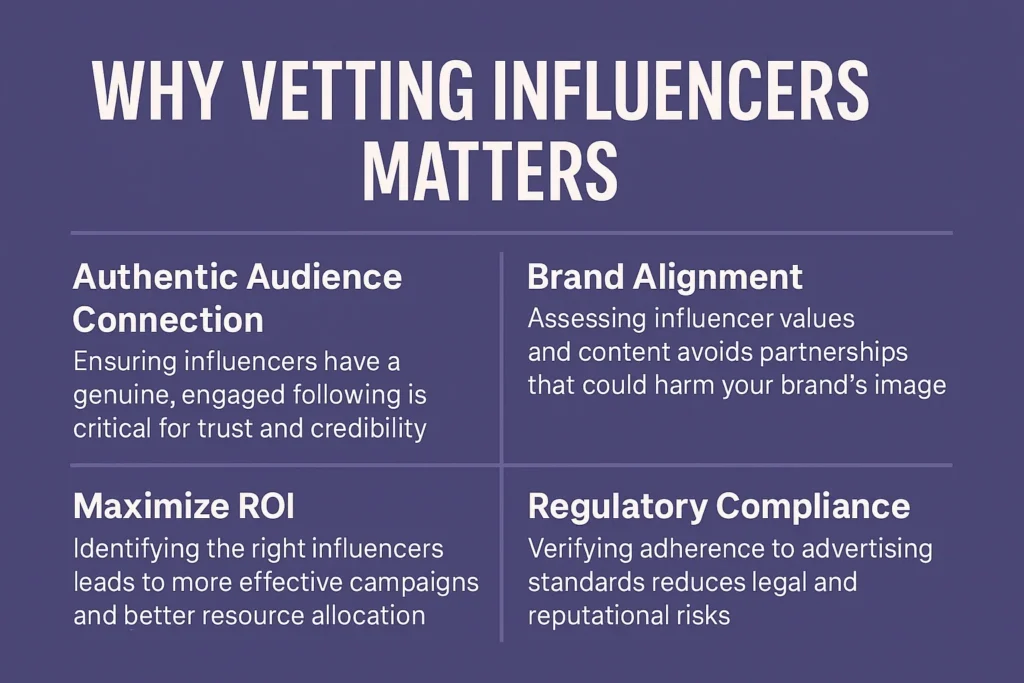Disclaimer: The information provided in this article is for general informational purposes only and does not constitute professional financial or business advice. Always conduct your own research or consult with a qualified expert before making marketing or partnership decisions.
If you’ve ever been disappointed by an influencer campaign, you’re not alone. The explosion of influencer marketing has brought numerous opportunities for brands. Still, it has also created a breeding ground for inauthentic creators who inflate their numbers with fake followers or produce lackluster engagement. Avoiding these pitfalls isn’t about luck; it’s about having a bulletproof vetting strategy in place. As an influencer marketing agency, you should be committed to helping brands make savvy choices that drive real business results.
Why Vetting Influencers Matters

Partnering with influencers who have Inauthentic followers or low engagement can result in a wasted budget, disappointing campaign results, and even damage to your brand reputation. That’s why influencer vetting isn’t just a first step; it’s a cornerstone of any effective influencer marketing campaign.
Dangers of Fake Followers and Low Engagement
- Misleading Metrics: Inflated follower counts don’t mean authentic reach.
- Poor ROI: Little to no conversions, sales, or brand awareness.
- Reputational Risk: Associating with inauthentic influencers can erode trust among the audience.
Step 1: Analyze Follower Authenticity
Before looking at an influencer’s follower count, dig deeper to check the quality of their audience:
Warning Signs of Fake Followers
- Unusual follower spikes in short periods
- Many followers have no profile picture, bio, or posts
- Follower locations that don’t align with the influencer’s usual audience or your target market
Manual Checks vs. Tools
- Manual Review: Scroll through recent followers. Are many of them generic usernames, inconsistent with the influencer’s content or region?
- Third-Party Tools: Use platforms like Social Blade or HypeAuditor to track follower growth over time and flag suspicious activity.
Pro Tip: Don’t be fooled by “giveaway” spikes. Accounts can proliferate if they run contests, but be sure to check if those followers stick around and engage in the long term.
Step 2: Measure Engagement, Not Just Numbers
A large following means nothing without signal engagement. When evaluating influencers, marketers should focus on the following metrics:
Calculate Engagement Rate
Engagement Rate=Likes + Comments + SharesTotal Followers×100%
Engagement Rate Total Followers
Likes + Comments + Shares ×100%
- For nano-influencers (1,000–10,000 followers): 4–8% is healthy.
- For micro-influencers (10,001–100,000 followers): 2–4% is the benchmark.
- For macro/celebrity influencers (100,001+ followers): 1–2.5% is typical.
Look Beyond Likes
- Comment Quality: Avoid creators whose comments are mostly “Nice pic!” or filled with unrelated emojis; these signal inauthentic engagement or automated bots.
- Video Metrics: Do their Instagram or TikTok Reels receive views in line with their follower count?
- Content Consistency: Does engagement stay relatively stable across posts, or do “highs” only appear on contest/giveaway posts?
- Video Views: Are they in line with follower count? Low views with high followers = red flag.
Step 3: Ensure Audience Alignment
Not every audience is your target audience. Adequate influencer vetting involves analyzing audience alignment with a brand’s message to secure it reaches the right consumers.
- Ask for Analytics: Most influencers can provide demographic breakdowns (age, gender, location, interests).
- Content Fit: Is their style, tone, and message consistent with your brand values and campaign goals?
- Brand Safety: Investigate their recent activity for controversies or off-brand partnerships.
Step 4: Check Collaboration and Posting Habits
Authentic influencers engage with their niche and other creators:
- Do they tag or partner regularly with reputable brands?
- Are their partnerships natural, or do their feeds look like a paid ad board?
- Have previous brand collaborations been successful and well-received?
Check their interactions within the community. Authentic influencers engage in conversations and build credibility with both their followers and peers.
Step 5: Ongoing Monitoring During and After Campaigns
Ongoing monitoring is essential to make sure that influencer partnerships remain compelling and authentic throughout a campaign:
- Pre- and Post-Campaign Audits: Compare engagement metrics for sponsored vs. organic posts.
- Performance Tracking: Ask for and analyze campaign analytics after every partnership.
- Long-Term Partnerships: Monitor for follower retention, quality of engagement, and sales lift over time.
Summary Table: Warning Signs and What to Do
| Red Flag | What It Means | What to Do |
| Significant gaps between likes/comments | Possible engagement pods or purchased | Review comment quality |
| Sudden jumps in follower count | Purchased followers or giveaway spike | Check retention after spike |
| Low views on videos (Reels, TikTok) | Audience not real or content not resonating | Reconsider partnership |
| Irrelevant follower locations | Fake or non-targeted audience | Request audience insights |
| Generic/spam comments | Bots or low engagement | Increase vetting rigor |
Conclusion
Vetting influencers is essential to protect campaign outcomes and assures accountability. Diligence before, during, and after every campaign separates successful outcomes from expensive lessons.
The cost of overlooking Inauthentic followers or accepting less engagement is simply too high for modern brands. Through a thoughtful and methodical vetting process, you’ll protect your marketing budget, build meaningful collaborations, and achieve real, repeatable results.
Campaigns built on transparent, data-driven strategies tend to perform better. Strategic planning and transparency are crucial factors in campaign effectiveness.
Influencer campaigns that prioritize careful vetting are more likely to achieve strong performance across various industries, including e-commerce and wellness.











